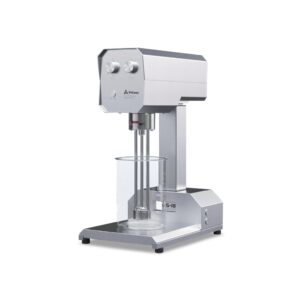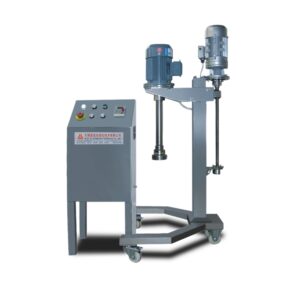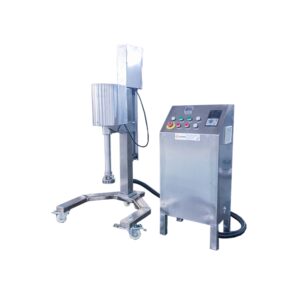-
What is a small homogenizer (mini homogenizer)?
(1) A small Homogenizer is a commonly used equipment in laboratories or small-scale production environments for homogenizing liquid or solid materials.
(2) Homogenization refers to mixing materials of different components evenly to achieve consistent physical and chemical properties.
(3) Small homogenizers typically have the following characteristics:
- Efficiency: It can quickly homogenize materials and improve production efficiency.
- Flexibility: Suitable for production and laboratory research of different scales, and operational parameters can be adjusted as needed.
- Diversity: It can be used to deal with various types of materials, including liquids, lotion, suspensions, colloids, etc.
(4) The working principle of a small homogenizer is mainly to shear, impact, and friction materials through high-speed rotating blades or mixers, so as to achieve a uniform and delicate state. This type of equipment is usually equipped with a control system that can easily adjust parameters such as speed and homogenization time to meet different production needs.
-
What is the application of small Homogenizer?
The application of small homogenizers is very extensive, mainly involving the homogenization and mixing of liquid and semi fluid materials. The following are the applications of small homogenizers in different industries:
(1) Food industry: Small homogenizers are used in the food industry to prepare various emulsions, suspensions and colloids, such as milk, soybean milk, fruit juice, beverages, ice cream, etc. Through homogenization treatment, the taste of food can be made more delicate, the consistency and stability of food can be improved, layering phenomenon can be prevented, and the shelf life of food can be extended.
(2) Pharmaceutical industry: In the pharmaceutical industry, small homogenizers can be used to prepare various pharmaceutical preparations, such as emulsions, suspensions, injections, etc. Through homogenization treatment, the bioavailability, absorbability, and stability of drugs can be improved, thereby enhancing the therapeutic effect of drugs.
(3) Cosmetics industry: Small homogenizer is used in cosmetics industry to prepare various lotion, essence, creams and other products. Homogenization treatment can make the ingredients of cosmetics more uniform, improve product stability and shelf life, and make the product more delicate and smooth.
(4) Chemical industry: In the chemical industry, small homogenizers can be used to prepare various materials such as pigments, coatings, and paints. Through homogenization treatment, the color concentration, brightness, and stability of materials can be improved, and product quality can be improved.
-
How many types of small Homogenizer?
There are various types of small homogenizers, and their specific classification can be based on different standards. The following are several types listed based on common classification methods:
(1) Classified by working principle:
- Shear homogenizer: The material is sheared, impacted, and rubbed through high-speed rotating shear blades to achieve homogenization effect.
- High pressure homogenizer: Utilizing high pressure to pass materials through narrow gaps or channels, subjecting them to strong shear and impact forces, thereby achieving homogenization.
- Ultrasonic homogenizer: Utilizes the vibration and cavitation effects generated by ultrasonic waves to homogenize materials.
(2) Classified by structural form:
- Handheld homogenizer: compact in size, easy to operate by hand, suitable for laboratory or small-scale production.
- Desktop homogenizer: placed on a table, with a relatively fixed structure, suitable for medium scale production.
- Floor mounted homogenizer: With a large volume, it needs to be installed on the ground and is suitable for large-scale production.
(3) Classified by application field:
- Food industry specific homogenizer: designed for the characteristics and needs of the food industry, suitable for homogenization treatment of food materials.
- Pharmaceutical industry specific homogenizer: meets the standards and requirements of the pharmaceutical industry, suitable for homogenization treatment of pharmaceutical preparations.
- Cosmetic industry specific homogenizer: designed for the characteristics and needs of the cosmetics industry, suitable for homogenization treatment of cosmetic materials.
-
What are the disadvantages and advantages of a small homogenizer?
(1) Advantages:
- High efficiency: Small homogenizers can quickly and uniformly mix or homogenize materials, improving production efficiency.
- Flexibility: Due to its small size, small homogenizers are very suitable for laboratories or small-scale production environments, and can easily adapt to different production needs.
- Easy to operate: usually designed to be simple and intuitive, easy for users to get started with, without the need for special training.
- Space saving: Suitable for environments with limited space and can be placed on a countertop or laboratory workbench.
- Versatility: It can handle various types of materials, such as liquid, lotion, suspension, etc., with a wide range of applications.
- Cost effectiveness: Compared to large homogenizers, the purchase cost of small homogenizers is usually lower, making them suitable for users with limited budgets.
(2) Disadvantages:
- Processing capacity limitations: Due to limitations in size and power, the processing capacity of small homogenizers is relatively low and may not be suitable for large-scale production.
- The homogenization effect may be limited: for certain high viscosity or high solid content materials, the homogenization effect of small homogenizers may not be as good as that of large equipment.
- Regular maintenance is required: In order to ensure the normal operation of the equipment and extend its service life, regular cleaning and maintenance are required.
- Noise and vibration: Some small homogenizers may produce noise and vibration during operation, which may have a certain impact on the working environment.
- Durability may be lower: compared to large equipment, small homogenizers may have poorer durability and require more frequent replacement of vulnerable parts.
- Not applicable to all application scenarios: Although small homogenizers are widely used, they may not be applicable in certain specific fields or applications that require special processing.










For most recent information you have to go to see web and on internet I found this web page as
a finest web site for hottest updates.